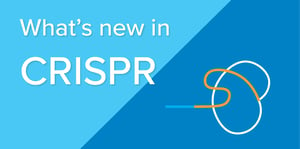 In this quarterly blog series, we’ll highlight a few of the new CRISPR plasmids available at Addgene. We will still periodically focus on specific CRISPR plasmid tools more in-depth, but we hope that this blog series will help you find new CRISPR tools for your research!
In this quarterly blog series, we’ll highlight a few of the new CRISPR plasmids available at Addgene. We will still periodically focus on specific CRISPR plasmid tools more in-depth, but we hope that this blog series will help you find new CRISPR tools for your research!
This time:
- GeneWeld vectors to create knock-ins
- CasX
- Drug inducible CRISPR/Cas9 activation
- E. coli genome-wide inhibition library
- CRISPR knockout libraries for cancer research
Creating knock-ins with GeneWeld vectors
GeneWeld from Jeffrey Essner’s lab uses CRISPR/Cas9 and a donor vector to create knock-ins of fluorescent proteins, fusion proteins, or transcriptional regulators. In this system, Cas9 generates a double-stranded DNA break at the genomic loci of interest and on either side of the cargo (ex: fluorescent protein gene) on the donor vector. Therefore, targeting requires two sgRNAS: one that targets the knock-in site and a universal sgRNA that targets the donor vector sequence. Homology arms that flank the donor plasmid cargo are complementary to either side of the double-stranded break in the genomic loci of interest. As the universal sgRNA is not predicted to target sites in the human, pig, or zebrafish genome, this system can be used in these organisms.
- Read the paper in bioRxiv
- Find the GeneWeld vector kit
CasX, a small Cas protein, is active in E. coli and human cells
Two years ago, Jennifer Doudna’s lab discovered a new Cas protein, CasX, from metagenomic analysis of microbial DNA from groundwater. Now, they’ve recently published data demonstrating that CasX is active in both E. coli and human cells. Using the structure of CasX at eight different states of assembly from cryo-electron microscopy, the team reveal the mechanism behind its activity including an extensive RNA scaffold and a domain needed for DNA unwinding. They’ve deposited plasmids for active and inactive CasX for E. coli and human expression.
- Read the paper in Nature
- Find the CasX plasmids
Drug inducible transcriptional activation and genome editing
Yu Wang's lab developed drug inducible CRISPR/Cas9 systems for transcriptional activation and genome editing by fusing Cas9 to a mutated human estrogen receptor. This protein fusion stays in the cytoplasm, but with the addition of 4-hydroxytamoxifen, it can move to the nucleus for activity. They also developed one of these systems further for simultaneous gene activation and editing.
- Read the paper in Nucleic Acids Research
- Find the drug inducible Cas9 plasmids
E. coli genome-wide inhibition library
In the last edition of “What’s New in CRISPR,” we shared with you an E. coli genome-wide inhibition library from the Chong Zhong lab. Now, we’ve included another E. coli genome-wide inhibition library from David Bikard’s lab. The Bikard library contains ~93,000 unique gRNAs that target random positions along the E. coli MG1655 genome with an NGG PAM motif, averaging 19 targets per gene. The lab has previously used the library with SpdCas9 to perform pooled CRISPRi screens to identify essential genes and phage host factors, and identify sequence-specific toxicity of Cas9.
- Read the paper in Nature Communications
CRISPR knockout libraries for cancer research
The Sidi Chen lab recently published two CRISPR knockout libraries for cancer research. The Mouse Metastasis CRISPR-Cpf1(Cas12a) Double Knockout Library is a lentiviral library targeting 26 genes chosen from an analysis of human metastasis cohorts and a prior mouse metastasis CRISPR screen. The Chen Mouse Tumor Suppressor Gene CRISPR Knockout Library is an AAV CRISPR knockout library targeting mouse tumor suppressor genes (TSG).
If you have a new CRISPR tool you’ve recently deposited to Addgene and you’d like it to be included in the next What’s New in CRISPR blog post, please let us know. We also welcome blog posts from guest bloggers. Check out this blog post for more information.
Additional resources on the Addgene blog
- Download the CRISPR 101 eBook
- Find our CRISPR 101 blog posts
- Read our CRISPR cheat sheet
Resources on Addgene.org
- Read our CRISPR guide
- Find CRISPR plasmids by function
- Find recently deposited plasmids
Topics: CRISPR, Other CRISPR Tools







Leave a Comment